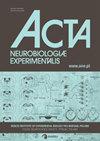Dissociable neuronal mechanism for different crossmodal correspondence effects in humans
IF 1.4
4区 医学
Q4 NEUROSCIENCES
引用次数: 0
Abstract
Crossmodal correspondences (CMCs) refer to associations between seemingly arbitrary stimulus features in different sensory modalities. Pitch‑size correspondences refer to the strong association of e.g., small objects with high pitches. Pitch‑elevation correspondences refer to the strong association of e.g., visuospatial elevated objects with high pitches. We used functional magnetic resonance imaging (fMRI) to study the neural components, which underlie the CMCs in pitch‑size and spatial pitch‑elevation. This study focuses on answering the question of whether or not different CMCs are driven by similar neural mechanisms. The comparison of congruent against incongruent trials allows the estimation of CMC effects across different CMCs. The analysis of the measured neural activity in different CMCs strongly pointed toward different mechanisms which are involved in the processing of pitch‑size and pitch‑elevation correspondences. Differential, whole brain effects were observed within the superior parietal lobule (SPL), cerebellum and Heschls’ gyrus (HG). Further, the angular gyrus (AnG), the intraparietal sulcus (IPS) and anterior cingulate cortex (ACC) were engaged in processing the CMCs but showed different effects for processing congruent compared to incongruent stimulus presentations. Within pitch‑size significant effects in the AnG and ACC were found for congruent stimulus presentations whereas for pitch‑elevation, significant effects in the ACC and IPS were found for incongruent stimulus presentations. In summary, the present results indicated differential neural processing in different simple audio‑visual CMCs.人类不同跨模态对应效应的可分离神经元机制
跨模态对应(CMC)指的是不同感官模态中看似任意的刺激特征之间的关联。音高-大小对应指的是小物体与高音之间的强关联。音调-高程对应指的是视觉空间高程物体与高音之间的强关联。我们使用功能性磁共振成像(fMRI)来研究神经成分,这些神经成分是音调大小和空间音调高低CMCs的基础。这项研究的重点是回答不同的 CMC 是否由相似的神经机制驱动。通过比较一致与不一致的试验,可以估计不同 CMC 的 CMC 效应。对不同 CMC 中测得的神经活动进行分析,结果强烈显示,参与音高-大小和音高-高程对应处理的机制各不相同。在顶上小叶(SPL)、小脑和赫氏回(HG)中观察到了不同的全脑效应。此外,角回(AnG)、顶内沟(IPS)和前扣带回皮层(ACC)也参与了 CMCs 的处理,但在处理一致与不一致的刺激呈现时显示出不同的效应。在音高大小方面,AnG 和 ACC 对一致的刺激呈现有明显的影响,而在音高高低方面,ACC 和 IPS 对不一致的刺激呈现有明显的影响。总之,本研究结果表明,在不同的简单视听 CMC 中存在不同的神经处理过程。
本文章由计算机程序翻译,如有差异,请以英文原文为准。
求助全文
约1分钟内获得全文
求助全文
来源期刊
CiteScore
2.20
自引率
7.10%
发文量
40
审稿时长
>12 weeks
期刊介绍:
Acta Neurobiologiae Experimentalis (ISSN: 0065-1400 (print), eISSN: 1689-0035) covers all aspects of neuroscience, from molecular and cellular neurobiology of the nervous system, through cellular and systems electrophysiology, brain imaging, functional and comparative neuroanatomy, development and evolution of the nervous system, behavior and neuropsychology to brain aging and pathology, including neuroinformatics and modeling.

 求助内容:
求助内容: 应助结果提醒方式:
应助结果提醒方式:


